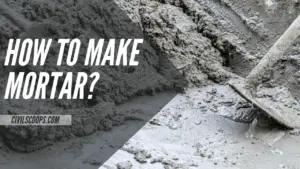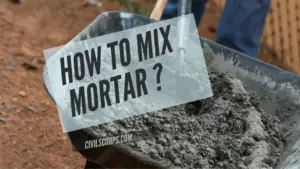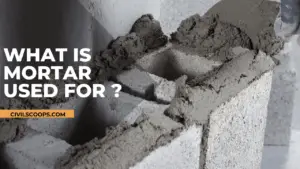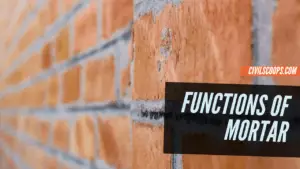All About of Mortar | What Is Mortar | How to Make Mortar | How to Mix Mortar | Mortar in Construction | Functions of mortar
Table of Contents
What Is Mortar?

Cement and water, or lime, Suki, and water are used to make mortar. The mortar’s joining ingredients are lime and cement. The mortars are strengthened by sand and suki. They also avoid unnecessary cracking caused by paste shrinkage.
As the proportion increases, the strength of mortars reduces. The best mixture is one cement to 36 sand. The amount of water needed for better results is 20 to 25% because it gives mortars the most strength. The mortars eventually absorb carbonic acid from the air and harden into a solid mass.
The following are some of the uses for mortar in architecture.
- Mortar is used to hold bricks or stones together in brick or stone masonry.
- It’s used to create a soft, even bed between layers of brick or stone masonry so that pressure is distributed evenly across the surface.
- It’s used to fill in gaps between bricks or stones in order to make walls more solid.
- It functions as a matrix in concrete.
- It’s used to hide joints and improve the appearance of plastering projects.
- It’s used for decorative purposes and for molding.
Mortar is applied to the bed and head joint surfaces of masonry units to both tie them together and hold them apart. Mortar increases the shear strength of the assemblage by evenly distributing gravity loads from one element to the next. Mortar also reduces the assemblage’s moisture permeability.
Traditional mortar is made up of clay, lime, and sand, with the cementitious materials to sand ratio usually about 1:3. A proprietary substance is known as “masonry cement” is used in some areas to replace the Portland cement and lime in the conventional blend. The use of masonry cement is forbidden in all but the lowest earthquake zones in the United States, according to the Uniform Building Code (UBC).
Mortar is traditionally prepared on-site, though the use of “ready-mixed” mortar has grown in popularity lately. Ready-mixed mortar contains admixtures for setting control that can be used for up to 2.5 hours after mixing.
Also , Read: Steel Is Stronger Than Concrete?
How to Make Mortar?

One or two cementitious materials, fine mason sand, and enough water to make a workable mixture make up masonry mortar. A portland cement/lime combination or masonry cement can be used as the cementitious material. By thickness, a standard mortar contains 1 part cementitious content to 2 14 – 3 12 parts sand.
How to Mix Mortar?

1. Mixing Mortar in a Cement Mixer:
- Switch on the mixer and pour a bucket of water (3–5 L) into it.
- For your project, use the required quantity of lime or mortar additive (see the table above). I use about a fifth of a bottle of Febmix Admix on a regular basis (common in the UK).
- Allow 30 seconds for the water and additive to rotate.
- Allow the first four shovels of sand to mix for a few minutes.
- Make sure the consistency is smooth. If it isn’t quite there yet, add some water.
- Add another shovelful of cement and mix for a few minutes more.
- Steps 1-6 can be repeated until you have the desired volume of mortar.
2. Mixing Mortar by Hand
- To blend the mortar, find a base or container. A wheelbarrow, a big plastic container, or a large wooden board may all be used.
- Measure about 4 parts sand then 1 part asphalt, and blend it dry on the surface with a shovel.
- Make a pit in the center of the mixture and pour in a bucket of water along with the required quantity of lime or mortar additive.
- Through shoveling the bottom of the mix to the surface and repeating, the mixture would be thoroughly mixed.
- If necessary, add more water to produce a perfect consistency.
- Steps 1–5 can be repeated before you have the desired quantity of mortar.
What Is Mortar Made Of?
Portland cement, hydrated lime, sand, and water are commonly used to make mortar. The product of mixing these materials is mortar, which is a solid binding agent used to close the spaces between bricks or other building blocks.
Also , Read: What Is Grade on Slab
What Is Mortar Used For?

- Because of their plasticity, workability, joining, and setting properties, various mortars are used for different purposes in civil engineering constructions.
- It is used to spread the load evenly over the lower bricks.
- In masonry work, mortars are used to create soft layers from bricks and stones.
- It was also used to join bricks and stones together.
- It also gives the water a lightness that protects it from the elements.
- Mortar is used as a wall and roof plaster or impermeable coating.
- To secure the brick joints during different styles of painting work.
- It’s used to conceal open brick and stonework joints.
- Mortars are used to fill in gaps of some kind of construction.
- It is used to enhance the structure’s overall appearance.
- It’s also used for various ornamental works to enhance a building’s or structure’s overall appearance.
Mortar in Construction
Mortar is a filler used to cover the spaces between bricks and blocks in masonry construction. Mortar is a paste made up of sand, a binder like mortar or lime, and water that is used as a paste and hardens.
Bricklaying Mortar
For masonry projects, bricklaying mortar is most commonly used to bind bricks, stones, and concrete blocks together. When the foundation is being constructed, bricklaying mortar may also be used as a bed to support these building materials from carrying an unequal weight distribution onto each other.
Finishing Mortar
Finishing mortar is often used in building projects that need plastering as well as those that choose to give the structure an aesthetically appealing appearance. Finishing mortar, which also contains lime and/or cement as a binding medium, is used to strengthen a structure’s resilience and mobility, as well as its resistance to harmful environmental events such as rain and wind.
Thinset Mortar
For projects including the construction of ceramic or cement, thin-set mortar may be used as a glue-like framework.
Mortar made of gypsum
The earliest known mortar was made of gypsum and was used by the ancient Egyptians. This shape was basically a plaster and sand mixture that was very soft.
Portland cement mortar
Portland cement mortar is made by combining Portland cement, sand, as well as water. It was created in the mid-nineteenth generation as part of the research attempts to produce more powerful mortars than those available at the time. It gained popularity in the late 1800s, and so by 1930, it’d have surpassed lime mortar as that the preferred mortar for new builds. The biggest explanation for this is that it hardens easily and allows for a higher building speed.
Also , Read: Steel Is Stronger Than Concrete | Steel Vs Concrete
Lime mortar
Sand, slaked lime, and water are combined to make lime mortar. The earliest recorded use of lime mortar was in Ancient Egypt around 4000BC. Making lime mortar is an easy procedure. Quicklime is made by burning limestone in a kiln. The quicklime is then slaked (mixed with water) to produce slaked lime, which can be used as putty or a powder. To make mortar, combine this with sand and water.
Such kind of lime mortar, called non, takes a long time to set due to the carbon dioxide in the air. It could take generations for a thick lime mortar wall to fully set or toughen.
The pace of the set could be accelerated by using unclean limestones in the kiln to create a hydraulic lime that sets when exposed to water. This kind of lime should be kept as a dry powder.
A pozzolanic material, including calcined clay or brick mud, can be applied to the mortar mix as just a substitute. Reacting with the water in the mortar would have a similar impact, causing the mortar to set very rapidly.
Functions of Mortar:

- Glues bricks or stones along.
- Ensures the structure’s stability.
- It provides force or balance between structural units.
- It acts as a critical medium for evenly dividing powers within the system.
- Provides extra resistance and strength against rain dispersion and other weathering agents.
- It is used to fill up gaps in brick or stone masonry. Grout, a thin liquid mortar, is commonly used for this purpose.
It’s critical to understand the consistency of the mortar as well as how the additives influence results. Let’s look at the various
Characteristics of a strong mortar in construction:
Workability of Mortar
- Workability is among the most critical characteristics of plastic mortar. The following are a few examples of workability indicators:
- The trowel spills the mortar quickly.
- The mass of the masonry units is supported by it.
- It sticks to the masonry surfaces.
- Whenever the mason applies pressure to the device, it quickly extruded plastic from the joint.
- The workability of fresh mortar also applies to the extensive properties of mortar that make it easier to build and maintain consistency, such as mobility and water retention. In general, a mortar with high mobility is easy to lay uniformly and thinly over the bricks, and it bonds well with the floors.
Strength of Mortar
When a mortar hardens, it is said to have high strength. However, using a good quality substance in reasonable quantities results in high-strength mortar. Along with the mortar, the final structure’s units must also be of high quality; only then can the structure last for a long time. As a result, ample cement content and well-graded fine aggregate are needed when preparing a high-strength mortar. Also, the water content must be just right; adding too much or too little water will degrade the strength consistency.
Water Retention of Mortar
The water-retaining capability of a high-quality mortar is very high. The water content of a mortar should not be reduced solely during transportation. If the water content of the mortar is separated or missing from the mix, the mortar will be difficult to harden and will lose its strength. Furthermore, where the surface lacks sufficient water, the mortar is unable to form a tight bond. Several kinds of plasticizers are used to improve the water-retaining capability of the mortar.
Like this post? Share it with your friends!
Suggested Read –
- All About of Fence | What Is Fence | Different Types of Fences | Advantages of Fence
- What Is Road Pattern | Different Types of Road Patterns
- What Is Formwork | Types of Formwork| Formwork in Construction| Formwork Materials
- What is MDF | Advantage s| Disadvantages| Application | Properties | Thickness
- What is FerroCement| Properties| Materials required| Uses| Advantages| Disadvantages
Frequently Asked Questions (FAQ)
What Are Mortar and Pestle?
Mortar and pestle is a set of two simple tools used from the Stone Age to the present day to prepare ingredients or substances by crushing and grinding them into a fine paste or powder in the kitchen, laboratory, and pharmacy.
How to Mix Mortar for Stone?
Whether making small repairs or building walls, knowing how to mix mortar requires precision. If the mortar is too dry, the block won’t stick together properly. If it’s too wet, runny mortar will overflow from the joints, leading to clean up that can waste time and material.
Mix mortar from scratch by blending one part Portland cement to three parts sand. If you use a ready mortar mix, the dry ingredients are already combined. Add one part water to three or four parts mix, depending on the type of job. Stir until mortar is smooth, typically 5-10 minutes. Allow the mix to rest 10 minutes before stirring again.
Mixing Mortar for Block
Mix mortar from scratch by blending one part Portland cement to three parts sand. If you use a ready mortar mix, the dry ingredients are already combined. Add one part water to three or four parts mix, depending on the type of job. Stir until mortar is smooth, typically 5-10 minutes.
Mortar Mix Ratio
The standard mortar mixing ratio is one part Portland cement to three parts sand. This varies depending on the type of mortar you need for your job. Add the sand to the concrete and use a mortar trowel or hoe to fold them together. Ensure the concrete and sand are completely mixed.
Lime Mortar Mix for Pointing
- Start with an empty mixer.
- Add 1 part sand.
- Mix in 1 part lime.
- Followed by 1.5 parts sand.
- Mix dry for at least 5 minutes.
- After 5 minutes slowly add water until the desired consistency is reached, it is very important not to drown the mix by adding too much water.
Originally posted 2022-05-23 06:44:41.

